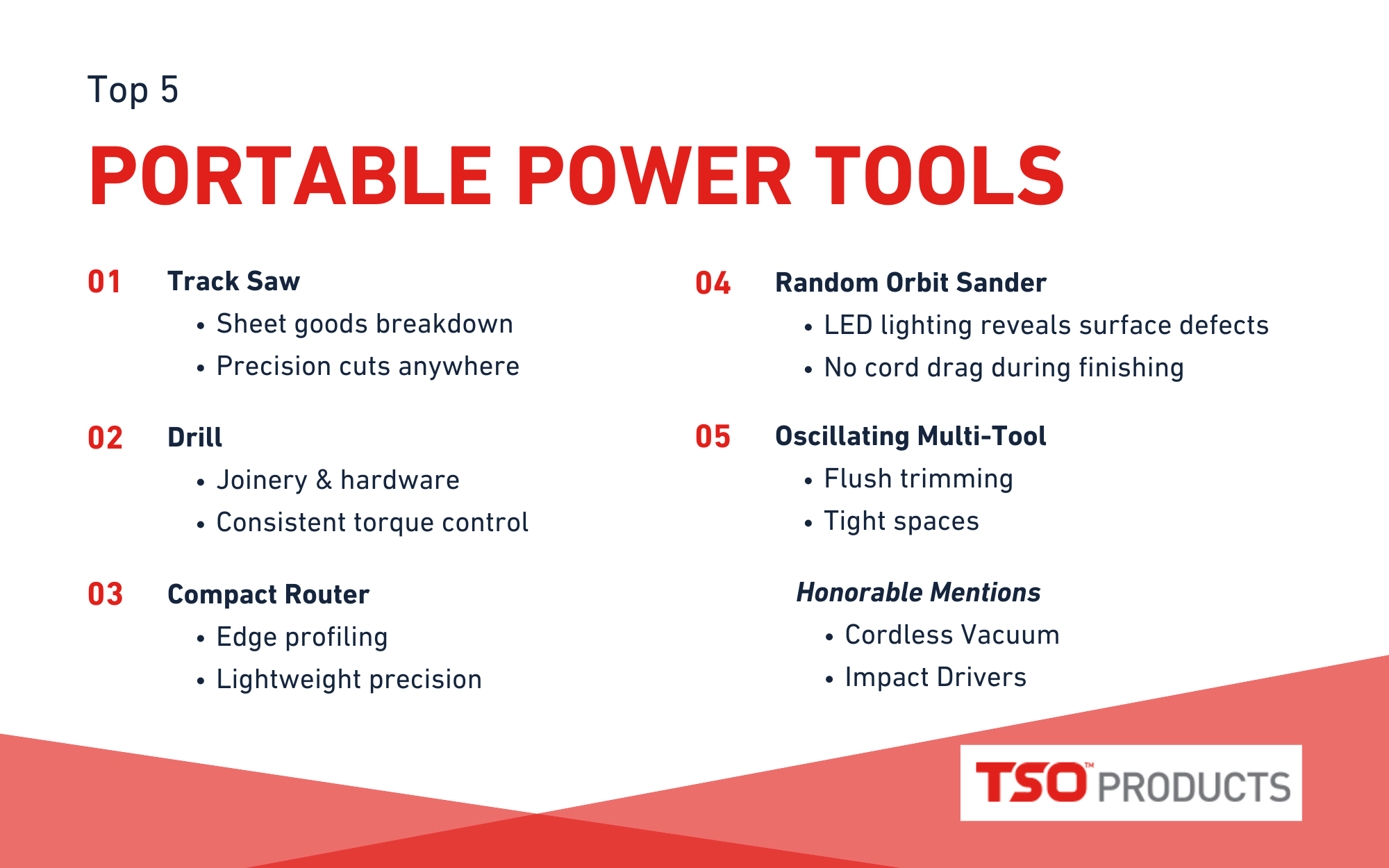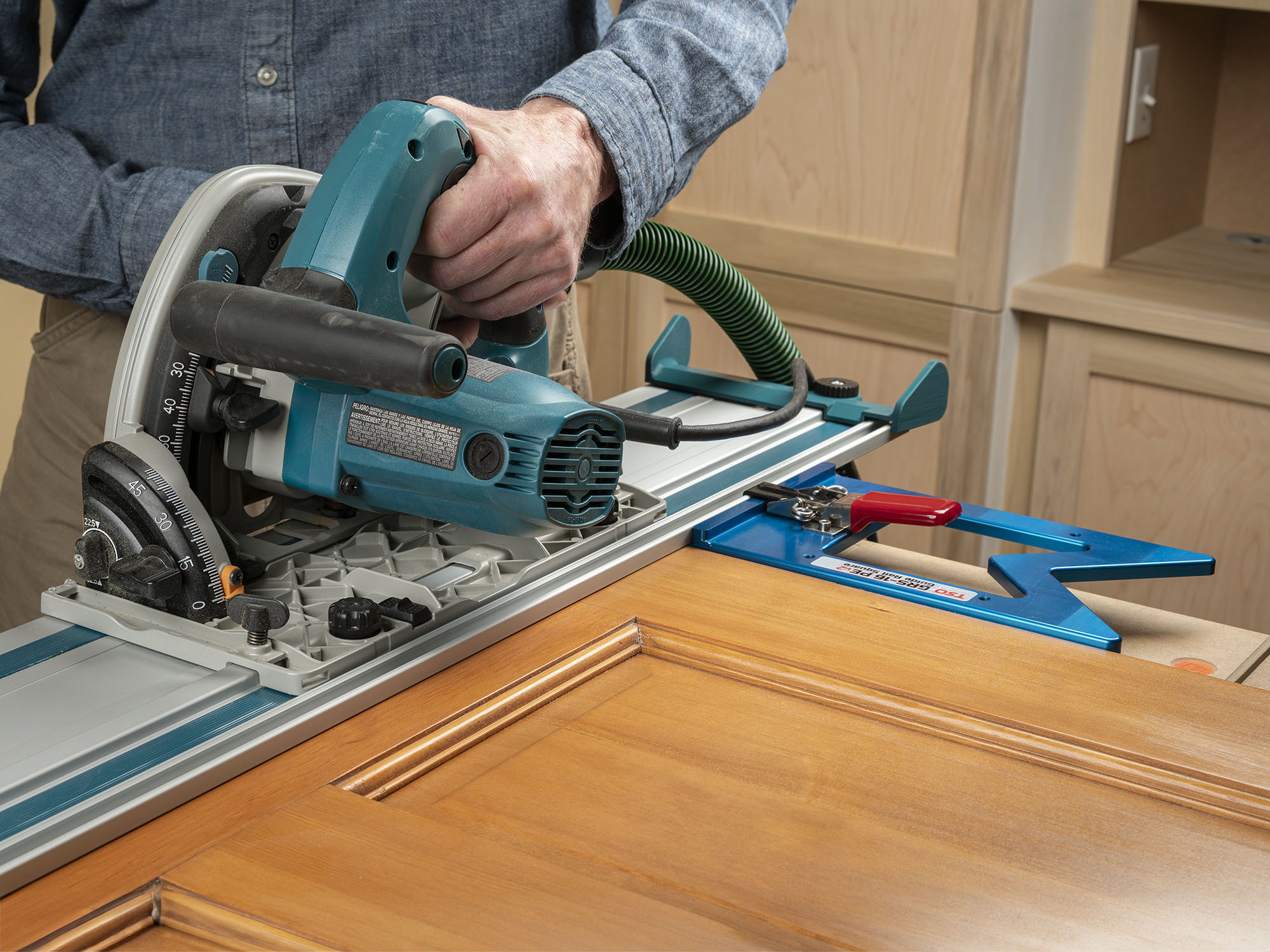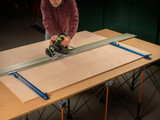Top Portable Power Tools Every Woodworker Should Own
The days of choosing between precision and mobility are behind us—today's portable power tools deliver the accuracy and power that serious woodworking demands.
Whether you're setting up in a tight garage, sharing space in a community workshop, or taking your craft on-site for custom installations, portable power tools allow you to maintain accuracy and productivity without being tied to a bench. The right portable arsenal means you can break down full sheets of plywood in your driveway or jobsite, tackle complex joinery at a temporary workstation, or handle detailed work in whatever space you have available—all with the same confidence you'd have in a fully equipped shop.
The market offers countless portable tool options, but not all deliver the reliability and precision that serious woodworking demands. This guide focuses on the top portable power tools we recommend having on hand—the proven performers that experienced woodworkers consistently rely on to deliver quality results, regardless of where the work takes them.
Why Portability Matters in the Workshop and On-Site
Flexibility drives efficiency in woodworking, and portable tools deliver both without compromise. When you can bring precision cutting, accurate drilling, and controlled routing directly to your workpiece, you eliminate the time lost moving materials between stations. A track saw at the lumber rack beats wrestling an 8-foot panel across the shop to your table saw every time.
Space constraints make portability essential rather than optional for many woodworkers. In shared workshops, portable tools mean you're not dependent on available bench time. In smaller shops, they allow you to work efficiently without dedicating floor space to every possible specialized operation. When storage is at a premium, a compact router that handles 90% of your profiling work makes more sense than a full-size machine that sits idle most days.
High-quality portable tools support repeatable accuracy through consistent setup systems and refined control mechanisms. Modern track saws achieve table saw precision with guide rails and multifunction worktops. Cordless drills with electronic clutches deliver repeatable torque. Compact routers with micro-adjustments handle delicate edge work with the same control as their benchtop counterparts.
Even seasoned professionals with fully equipped shops rely on portable tools for versatility. Fixed machinery excels at repetitive operations, but portable tools handle the exceptions—the angled cut that's awkward on the table saw, the mortise that's easier to rout in place, or the trim work that demands you bring the tool to the workpiece rather than the reverse. The most efficient workflows combine both approaches, using each tool where it performs best.

Must-Have Portable Power Tools for Woodworkers
The following tools form the core of any serious portable toolkit. Each addresses specific challenges that arise when precision work moves beyond the traditional bench setup.
Track Saw System
Breaking down sheet goods with accuracy defines the track saw's primary value. A well-designed track saw replaces larger table saw setups when space is limited or you're working remotely or working alone, delivering the same straight, splinter-free cuts that define quality work.
The track system eliminates the measuring and marking that slows down panel breakdown—especially when accessories like Guide Rail Squares or Parallel Guide Systems are added. Place your guide rail on the workpiece, check your measurement once, and make your cut with confidence. Modern track saws from manufacturers like Festool, Makita, and DeWalt handle everything from 1/4-inch plywood to thicker hardwoods (when used with a low-tooth-count hardwood blade) with similar precision, making them indispensable in the shop or on the job.
Compatibility with accessories like Guide Rail Squares and Parallel Guides extend precision beyond simple straight cuts. A quality Guide Rail Square ensures perfect 90° and 45° crosscuts, while Parallel Guides ensure every rip is perfectly parallel. These accessories transform a track saw into a complete cutting system.
Cordless Drill
Joinery, installation, and finishing require tools that deliver consistent results under varied conditions. A matched drill and impact driver set provides the torque, runtime, and control needed for everything from pilot holes to cabinet hardware installation.
Battery platform integration drives the primary decision here—matching your drill and driver to your existing tool ecosystem eliminates charger proliferation and ensures consistent runtime across your portable arsenal. Quality battery systems maintain power output throughout the charge cycle, critical when you're working away from convenient charging stations.
Ergonomics and build quality separate tools you'll reach for daily from those that sit in the case. Well-balanced tools with comfortable grips reduce fatigue during extended sessions, while robust construction handles the inevitable drops and impacts of active woodworking. Speed and power capabilities matter for efficiency—variable speed control for precision work and enough torque for driving large screws into hardwood without bogging down.
Attachment compatibility extends versatility significantly. Right-angle attachments handle tight spaces, while specialized attachments like Festool's CentroFix system enable precise drilling for hardware installation and joinery work.
Portable Router (Trim or Compact Router)
Edge profiling, mortising, and joinery tasks often require bringing the tool to the work rather than the reverse. A compact router provides the precision of a full-size machine while weighing a fraction, making it ideal for operations where control matters more than raw power.
Compact routers excel at tasks that full-size machines handle awkwardly. Edge profiles on installed cabinets, small mortises for hardware, and template work all benefit from the improved control and reduced weight. The smaller form factor allows better visibility of the cut line and the ability to fit into tight spaces.
The right base and bit setup maximizes a compact router's capabilities. A quality edge guide handles straight edge work with precision similar to a router table, while template guides enable accurate joinery and hardware installation. Variable speed control accommodates different bit sizes and materials, ensuring burn-free cuts across a range of applications.
Random Orbit Sander
Surface preparation and finishing work often happen away from dust collection systems, making cordless sanders essential for achieving consistent results across varied work environments. Recent advances in cordless sanding technology have transformed these tools from compromised alternatives into legitimate replacements for corded models.
Recent innovations address the critical challenge of surface inspection during sanding. Festool's latest cordless sanders incorporate integrated LED lighting systems that illuminate the work surface from optimal angles, making sanding marks, pigtails, and other surface imperfections immediately visible. This real-time feedback prevents the common problem of discovering scratches or missed areas after stain or finish application.
Dust collection capabilities in cordless models now rival corded alternatives when paired with appropriate vacuum systems. Advanced dust ports and improved airflow design ensure effective debris removal, critical for both surface quality and workspace cleanliness. The combination of effective dust collection and cord-free operation makes these tools particularly valuable for final sanding operations on installed work or in finished spaces.
Cordless Oscillating Multi-Tool
Flush trimming, plunge cutting, and detail work often require accessing tight spaces or making precise cuts where other tools can't reach. An oscillating multi-tool serves as the problem-solver for situations where conventional tools fall short.
The oscillating action allows controlled material removal without the risk of overcut that comes with rotary tools. Flush trimming dowels or plugs, cutting trim for new flooring installation, and removing damaged sections for repair work all benefit from the precise control an oscillating tool provides.
Tight spaces and awkward angles define this tool's primary advantage. Under-cutting door trim for flooring installation, accessing fasteners in confined areas, and making relief cuts in complex assemblies all become manageable tasks. The compact head and multiple attachment options ensure you can adapt the tool to the specific requirements of each job.
Honorable Mentions
Some additional tools that deserve consideration for specific workflows and working conditions:
Cordless Jobsite Vacuum maintains clean work areas when space and dust collection systems are limited. Efficient portable vacuums with tool-triggered operation integrate into workflows without interrupting the work rhythm. In shared spaces or client locations, maintaining cleanliness demonstrates professionalism while improving safety and visibility during precision work.
Impact Drivers deliver high-torque fastening without the wrist-jarring feedback that comes from standard drill/drivers, making them essential for extended fastening sessions. The rotational hammering action delivers torque through quick bursts rather than constant resistance, dramatically reducing strain during repetitive screw driving. Long screws into hardwood become manageable tasks rather than endurance tests, while preventing cam-out and stripped heads. Modern impact drivers balance power with control, making them versatile for both delicate finish work and structural connections.
Choosing the Right Portable Power Tools
Selecting portable tools requires different considerations than choosing stationary equipment. The demands of varied working environments and the need for system integration shape these decisions more than raw specifications.
Battery platform consistency eliminates the frustration of incompatible chargers and reduces the cost of maintaining multiple tool systems. Committing to a single manufacturer's battery platform means your drill, circular saw, and oscillating tool share power sources and charging infrastructure. This consistency becomes critical when working on-site or in situations where bringing multiple chargers isn't practical.
Accessory compatibility extends a tool's capabilities beyond its basic function. A track saw that accepts aftermarket accessories offers more long-term value than one locked into a proprietary system. Similarly, routers that accept standard template guides and edge guides integrate better into existing workflows and jig systems.
Durability in varied working environments separates tools designed for daily professional use from those intended for occasional projects. Construction-grade tools handle temperature extremes, dust exposure, and the inevitable impacts of active work. Sealed switches, reinforced housings, and corrosion-resistant components ensure reliable operation whether you're working in a climate-controlled shop or an unheated garage in winter.
Function over brand determines the best choice for your specific needs—except when battery platform compatibility overrides everything else. Once you're committed to a battery system, you're often choosing the best tool within that ecosystem rather than the absolute best tool available. A Makita user isn't realistically going to buy a single Festool drill, regardless of how superior it might be for specific tasks.
This reality means evaluating tools differently than you would corded equipment. Within your chosen battery platform, prioritize repeatability, control, and quality of results. A tool that consistently delivers accurate results using your existing batteries outperforms a technically superior option that requires a new charging infrastructure. The cost and complexity of maintaining multiple battery systems usually isn't justified unless you have very specific performance requirements that can't be met within your primary platform.
 Putting Portable Tools to Work
Putting Portable Tools to Work
Portable power tools don't replace larger machines—they complement them by handling the tasks that fixed equipment can't address efficiently. The most productive workshops combine both approaches, using each type of tool where it performs best. Stationary tools excel at repetitive operations and high-volume work, while portable tools solve the exceptions and handle work outside the shop.
The right selection empowers woodworkers to maintain precision regardless of workspace constraints. Whether you're working in a compact garage, sharing shop time, or taking your craft on-site, quality portable tools ensure that space limitations don't compromise the quality of your work. They provide the flexibility to adapt your methods to the demands of each project rather than forcing projects to fit your equipment limitations.
Evaluate your workflow and identify where portable tools can remove friction or improve efficiency. Consider the time spent moving materials between stations, the projects you've avoided due to space constraints, and the situations where bringing tools to the work would be more efficient than the reverse. Start with the tools that solve the biggest pain points in your workflow—whether it’s clean sheet good cuts or reliable mortising in the field—and build from there.
Recent Posts
-
What Size Guide Rail Do I Need? Choosing the Right Length (and When to Use Extensions)
The scenario: you need to make a cut in that full size plywood panel sitting in the corner of your s …6th Nov 2025 -
Best Track Saw Systems: Expert Review & Advice
The track saw market has changed considerably over the past three years. Back then, your options wer …6th Nov 2025 -
Systainer Storage Guide: Organize Your Workshop Tools
Picture this: you're setting up for what should be a straightforward series of cuts, but you can't l …2nd Sep 2025




